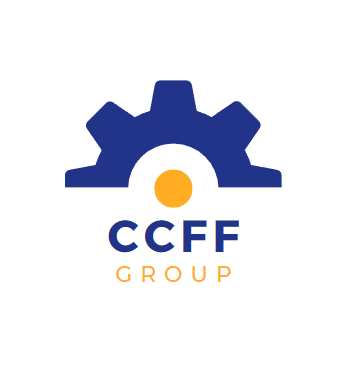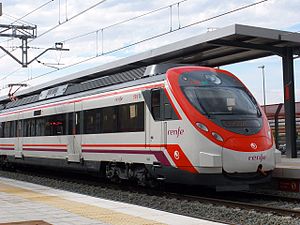Compañía de Construcciones y Forjas Ferroviarias (CCFF)
 | |
| Company type | Public |
|---|---|
| CFP | |
| ISIN | NL0015000LU4 |
| Industry | Manufacturing |
| Founded | 1882 as “Metales y Rieles de Montia” |
| Headquarters | , |
Area served | Worldwide |
Key people | Domínico Holler (CEO) |
| Products | Trains Buses Machinery Cars |
| Services | Transportation |
| Revenue | |
Number of employees | Approximately 45,000 |
| Subsidiaries | List |
Compañía de Construcción y Forjas Ferroviarias (CCFF, literally "Company of Construction and Railway Forges") is a Pelaxian publicly listed company which manufactures railway vehicles, rolling stock, heavy industrial equipment and buses through its MontiaBus subsidiary. It is based in Montia, Pelaxia. Equipment manufactured by CCFF includes light rail vehicles, rapid transit trains, railroad cars and locomotives, as well as variable gauge axles that can be fitted on any existing truck or bogie. Over the 70 years from the early 1950s, CAF benefited from the rail investment boom in its home market in Pelaxia to become a world player with a broad technical capability, able to manufacture almost any type of rail vehicle. The company has supplied railway rolling stock to a number of major urban transit operators around Alshar, Levantia and Sarpedon.
The company is well known for its Búfalo Steam Engine series. And its the first train and rolling stock manufacturer and supplier in Pelaxia, followed by Talleres Ferroviarios Nacionales
History
The company started out as the Metales y Rieles de Montia (Metals and Rails of Montia) during the Solis Government in 1882 manufacturing machines, rails and rolling stock for the mining industry and founded by Ernesto Lima. By 1901 the company was employing over 3,000 people. As similar control mechanisms were used for steam-driven automated weaving looms and for stream-driven railway traversers and turntables, Lima also founded the Motores Lima (Lima Engines) in 1910. In the 1950s the company stopped manufacturing normal locomotives and started to concentrate on tracking machines (ballast tampers), and adopted its current name. Since the early 1990s, CCFF has also been active internationally. In the early 2000s, CCFF supplied electric and high-speed trains to the Pelaxian VDP, Transcon, Metrolink and Central, and in 2005, high-speed trains were exported for the first time.
Subsidiares
CCFF manufactures specialised rail vehicles used for infrastructure and service trains, as well as electric and diesel shunting machines, shunting locomotives, steam locomotives and stationary shunting equipment. The company also manufactures a wide variety of rail service equipment including lifting equipment, traversers and turntables and equipment for wheelset maintenance including wheel and bogie drop machines, and wheelset and bogie measuring equipment. CCFF has a contract to supply VDP with a factory train which will be used in the Albalitor-Vila Real HSR project. The company also manufactures equipment for heavy industrial plants, including steel-works equipment such as ladle transporters and tippers, torpedo wagons, and machinery for steel coil handling.









